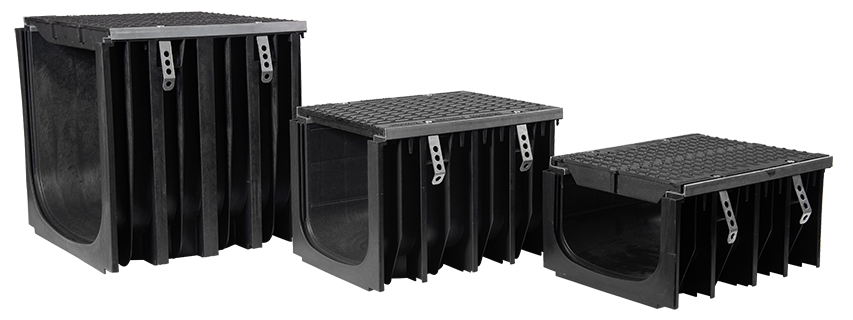Water management is an indispensable aspect of sustainable development, particularly in regions prone to flooding or water scarcity. In the face of climate change and urbanisation, the need for efficient drainage systems that can handle high volumes of water while also retaining it for beneficial use has become increasingly critical. High-capacity drainage channels offer a promising solution to this challenge, providing a balance between flood control and water conservation. This article delves into the concept of high-capacity drainage channels, their design principles, benefits, and applications in modern water management practices.
Understanding High Capacity Drainage Channels
High-capacity drainage channels are engineered structures designed to efficiently convey large volumes of water, primarily during heavy rainfall events, while also incorporating features for water retention and infiltration. Unlike conventional drainage systems that focus solely on rapid water removal, high-capacity channels aim to mitigate flooding by temporarily storing excess water and gradually releasing it or allowing it to infiltrate into the ground.
Design Principles
The design of high-capacity drainage channels integrates various principles to optimize their performance in managing water flow and retention. Key design considerations include:
- Hydraulic EfficiencyChannels are engineered to maximize hydraulic efficiency, ensuring swift conveyance of water to prevent localized flooding. Smooth, sloped surfaces and streamlined geometries minimize friction and resistance, enabling rapid water movement.
- Storage CapacityHigh-capacity channels feature enlarged storage areas or basins capable of temporarily storing excess water. These storage elements help attenuate peak flows, reducing the risk of downstream flooding.
- Infiltration & PermeabilityIncorporating permeable materials or features such as porous pavements or vegetated swales promotes infiltration of water into the soil, replenishing groundwater reserves and reducing surface runoff.
- Sustainable PracticesSustainable design practices, such as incorporating green infrastructure elements like rain gardens or bio-retention cells, enhance the ecological benefits of drainage channels by promoting biodiversity and natural water filtration.
Benefits of High Capacity Drainage Channels
High-capacity drainage channels offer a multitude of benefits that address both flood control and water conservation objectives:
- Flood MitigationBy efficiently conveying and temporarily storing excess water, these channels help mitigate the risk of flooding, safeguarding communities and infrastructure against water-related disasters.
- Water ConservationRetaining water within drainage systems allows for its gradual release or infiltration, facilitating groundwater recharge and reducing the strain on municipal water supplies during dry periods.
- Erosion ControlControlled water release and infiltration minimize soil erosion and sedimentation in water bodies, preserving water quality and ecosystem integrity.
- Urban GreeningIncorporating green infrastructure elements into drainage channels enhances urban aesthetics, promotes biodiversity, and provides recreational opportunities for communities.
- Climate ResilienceHigh-capacity drainage channels contribute to climate resilience by adapting to changing precipitation patterns and mitigating the impacts of extreme weather events, such as intense rainfall and storms.

Applications of High Capacity Drainage Channels
High-capacity drainage channels find application in various urban and rural settings, including:
- Urban Stormwater ManagementIn urban areas, these channels are integrated into stormwater management systems to alleviate pressure on conventional drainage infrastructure and reduce urban flooding risks.
- Transportation InfrastructureAlong highways and roadways, high-capacity drainage channels prevent roadway inundation and ensure safe passage for vehicles, enhancing transportation resilience.
- Commercial and Industrial SitesIndustrial facilities and commercial developments utilize high-capacity drainage channels to manage stormwater runoff and comply with regulatory requirements for water quality management.
- Agricultural DrainageIn agricultural landscapes, these channels aid in controlling excess water on fields, preventing waterlogging and facilitating crop growth while minimizing nutrient runoff into water bodies.
- Natural Resource ConservationHigh-capacity drainage channels play a vital role in protecting natural habitats, wetlands, and riparian zones by regulating water levels and preserving ecological integrity.
Challenges and Considerations
Despite their numerous benefits, the implementation of high-capacity drainage channels may encounter challenges such as:
- CostThe initial construction and maintenance costs of high-capacity drainage systems can be significant, requiring investment in infrastructure and ongoing monitoring and maintenance.
- Land Use & Space ConstraintsSecuring adequate land for constructing drainage channels, especially in densely populated urban areas, may pose challenges due to competing land uses and space limitations.
- Regulatory ComplianceCompliance with regulatory standards for stormwater management and environmental protection adds complexity to the design and implementation of drainage systems, necessitating adherence to stringent guidelines and permitting processes.
- Maintenance RequirementsRegular maintenance and cleaning of drainage channels are essential to ensure their optimal performance and prevent clogging or sedimentation, requiring dedicated resources and personnel.
- Community EnagementEffective stakeholder engagement and community involvement are critical for garnering support for drainage projects, addressing concerns, and ensuring the integration of local knowledge and preferences into design decisions.
Conclusion
High-capacity drainage channels represent a versatile and effective solution for addressing the dual challenges of urban flooding and water scarcity. By combining hydraulic efficiency with water retention and infiltration capabilities, these systems offer a sustainable approach to water management that promotes resilience, conservation, and environmental stewardship. While challenges such as cost, regulatory compliance, and maintenance exist, the benefits of high-capacity drainage channels outweigh these hurdles, making them indispensable components of modern water management strategies. Through continued innovation, collaboration, and investment, the widespread adoption of high-capacity drainage channels can contribute to building more resilient and water-secure communities for generations to come.